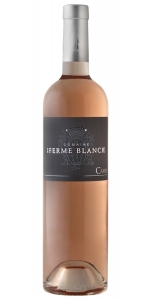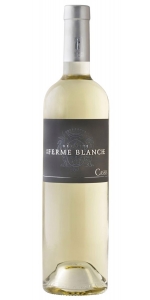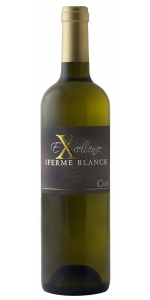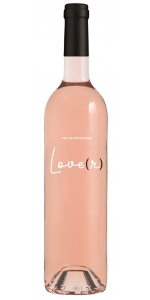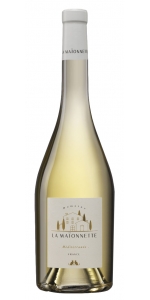Wine from Provence
Ferme Blanche Cassis Blanc is made from 40% Marsanne, 20% Ugni Blanc, 20% Clairette, 10% Sauvignon Blanc and 10% Bourboulenc. .
The wine has a pale golden color and offers subtle aromas of citrus fruits, peach and apricot, and floral notes of acacia and linden. Crisp and lively on the palate, good tension and length and a refreshing finish.
Sea stews, shellfish, traditional fish and chips, octopus salad.
Ferme Blanche Cassis Blanc Excellence is made from 40% Marsanne, 20% Ugni Blanc, 20% Clairette, 10% Sauvignon Blanc and 10% Bourboulenc.
The wine has a pale golden color and offers subtle aromas of citrus fruits, peach and apricot, and floral notes of acacia and linden. Crisp and lively on the palate, good tension and length and a refreshing finish.
Pair with sea stews, shellfish, traditional fish and chips, octopus salad.
Ferme Blanche Cassis Blanc Excellence is made from 50% Marsanne and 50% Clairette.
On the nose, white fruits, citrus zest, hint of vanilla. Velvety well balanced mouth of ripe fruits and minerality.
Pair with trout, Scallop, or better yet lobster would complement this wine perfectly.
Ferme Blanche Cassis Blanc Excellence is made from 50% Marsanne and 50% Clairette.
On the nose, white fruits, citrus zest, hint of vanilla. Velvety well balanced mouth of ripe fruits and minerality.
Pair with trout, Scallop, or better yet lobster would complement this wine perfectly.
Ferme Blanche Cassis Blanc Excellence is made from 50% Marsanne and 50% Clairette.
On the nose, white fruits, citrus zest, hint of vanilla. Velvety well balanced mouth of ripe fruits and minerality.
Pair with trout, Scallop, or better yet lobster would complement this wine perfectly.
This dry rosé has a beautiful light color. Its displays aromas of red fruits with a nice, refreshing and clean finish. There is also a touch of minerality.
Love(R) Coteaux d'Aix en Provence Rosé is delicious with BBQ, lasagnas, grilled fish as well as a fresh Mediterranean salad.
Maionnette Mediterranee Blanc is made from 30% Rolle, 30% Viognier, 20% Semillon and 20% Sauvignon Blanc.
Domaine de la Maïonnette is produced from grapes benefiting from an ideal location next to the river and planted on a clay-limestone based soil with a silty character, which brings suppleness, roundness and lightness to the wines.
La Maionnette is a brilliant straw yellow colored white offering delicate aromas of citrus fruits, and fresh notes of pear and apricot. Rich and round on the palate, and a good balance.
- back
Selected Options
Regions
Categories
Pricing
Countries
Regions
Grape Types
Wineries
Organic/Free Shipping
Winemaking: This wine is a classic Bordeaux blend of 78% Cabernet Sauvignon, 10% Malbec, 8% Merlot, 2% Cabernet Franc, 2% Petit Verdot.
. The 2010 growing season was moderate, thus promoting slow ripening and full flavor development. We hand-harvested and fermented each variety separately, then moved the wines to barrel, where they aged twelve months. Once we determined our blend, we returned the wine to barrel for an additional twelve months, to 'marry' the varietals. We used tight-grained French oak barrels (45% new) from coopers Taransaud, Vicard and Bossuet.
Winemaker Notes:
Complex, rich aromas foretell rich flavors of black currants, allspice and a hint of clove. The wine is full bodied, with velvety texture, smooth tannins and an extensive finish. Beautifully balanced, this Cabernet will age for ten more years.
Alcohol: 14.25 percent by volume
Review:
"Savory, dried red capsicum with cedar, cocoa powder and dried mushrooms on top of black cherries. Juicy and layered with some currants and savory earthy spices on the palate. Not quite deep, but a very elegant and savory expression of cabernet with a very long, subtle finish. A little sweet-sour, but quite refined and approachable, too. Drink now."
- James Suckling (June 2022), 93 pts
Chavy-Chouet Bourgogne Blanc Femelottes is made form 100 percent Chardonnay.
This is a charming, rich, focused and delightful white. Medium-bodied with a smooth texture, the wine has a fresh backbone of acidity, clean apple and citrus flavors, and an excellent balance. A most refreshing quaff and one that is great value. A delicate, expressive wine of exceptional quality.
The grapes from this wine are grown from the Puligny-Montrachet area. (either outside of the AOC limit or with younger vines).
The grapes from this wine are grown from the Puligny-Montrachet area. (either outside of the AOC limit or with younger vines).
Aged 10 months in oak barrels (10% new, the rest in 2-3 year old barrels).

